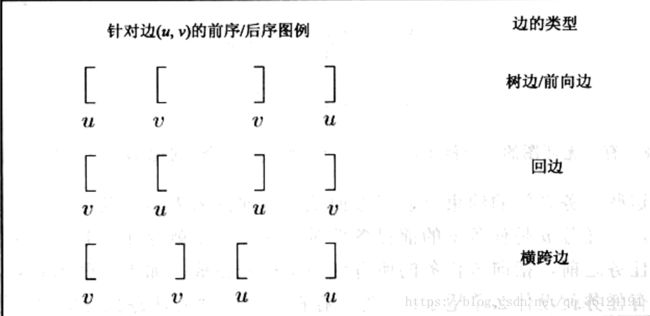算法分析与设计第三周练习(图论)
目录
Evaluate Division
Reconstruct Itinerary
总结
Evaluate Division
1. 题目
Equations are given in the format A / B = k, where A and B are variables represented as strings, and k is a real number (floating point number). Given some queries, return the answers. If the answer does not exist, return -1.0.
Example:
Given a / b = 2.0, b / c = 3.0.
queries are: a / c = ?, b / a = ?, a / e = ?, a / a = ?, x / x = ? .
return [6.0, 0.5, -1.0, 1.0, -1.0 ].
The input is: vector, where equations.size() == values.size(), and the values are positive. This represents the equations. Return vector.
According to the example above:
equations = [ ["a", "b"], ["b", "c"] ],
values = [2.0, 3.0],
queries = [ ["a", "c"], ["b", "a"], ["a", "e"], ["a", "a"], ["x", "x"] ].
The input is always valid. You may assume that evaluating the queries will result in no division by zero and there is no contradiction.
2. 分析
2.1 基础知识
图论的内容是算法中比较重要并且难度比较大的一部分内容,在课本的第三章都是与图论有关的内容,并且这一整章的内容都是以DFS算法为基础的,图基于DFS算法的应用有(基于课本):
1. 简单的DFS算法。
2. 判断图树边,前向边,回边。
通过在遍历前和遍历后的时钟进行计时,通过时钟的计时可以判断出具体的边,具体的规则如下:
3. 通过边的类型判断图是否有环,如果通过DFS发现有回边,则图有环。其实这里还可以通过节点的入度判断图是否有环, 具体是从源点开始遍历,遍历完了有这个点有边的节点入度减1,最后如果有节点入度不等于0,则图有环。
4. 拓扑排序,可以通过时钟计时的方式找出拓扑排序。
5. 最后一个是图的连通性,强连通性等等。
2.2 解体思路
我们需要对这题的元素进行一些抽象,这题给定了一些预定义的公式,然后通过预定义公式的演化求出目的公式的值,这样看起来是比较具体的,然后我们抽象出来一个模型,这个模型就是图。
由于公式之间的运算只有一种运算,所以我们可以将预定义两个字符得运算看成是构成图的边,并且这个边是双向的,但权值不一样,按照预定义的公式,我们得出了一个图,但图有两种表述方式,一种是邻接矩阵,一种是邻接链表,明显,邻接链表是最常用的,我们这里采用邻接链表,但需要做一些变形,因为这样有权值和string类型需要表达进数据结构当中,其数据结构是:
map>> graph; 由于我们需要存某个点相邻的点及其权值,这样可以有利于搜索。
图建立好以后,我们需要求任何两个点的计算的值,也就是说,我们需要找出这两个节点的路径,寻找的办法是DFS,同时还需要距离路径的权值,抽象为图论问题去解决就是搜索某条路径及其权值,而权值恰好就是两个string相除的值。
3. 源码
class Solution {
public:
double dfs(string source, string dest, set &visited, map>> &graph) {
if(source == dest) {
return 1.0;
}
visited.insert(source);
for(int i = 0; i < graph[source].size(); i++) {
if(visited.find(graph[source][i].first) == visited.end()) {
double num = dfs(graph[source][i].first, dest, visited, graph);
if(num != -1.0) {
return (num*graph[source][i].second);
}
}
}
return -1.0;
}
vector calcEquation(vector> equations, vector& values, vector> queries) {
map>> graph;
for(int i = 0; i < equations.size(); i++) {
graph[equations[i].first].push_back(make_pair(equations[i].second, values[i]));
graph[equations[i].second].push_back(make_pair(equations[i].first, 1/values[i]));
}
/* for(auto a : graph) {
cout << a.first << endl;
}
*/
vector result;
for(int i = 0; i < queries.size(); i++) {
if(graph.find(queries[i].first) == graph.end()) {
result.push_back(-1.0);
continue;
}
set visited;
string source = queries[i].first;
string dest = queries[i].second;
double num = dfs(source, dest, visited, graph);
result.push_back(num);
}
return result;
}
}; Reconstruct Itinerary
1. 题目
Given a list of airline tickets represented by pairs of departure and arrival airports [from, to], reconstruct the itinerary in order. All of the tickets belong to a man who departs from JFK. Thus, the itinerary must begin with JFK.
Note:
- If there are multiple valid itineraries, you should return the itinerary that has the smallest lexical order when read as a single string. For example, the itinerary
["JFK", "LGA"]has a smaller lexical order than["JFK", "LGB"]. - All airports are represented by three capital letters (IATA code).
- You may assume all tickets form at least one valid itinerary.
Example 1:
Input:[["MUC", "LHR"], ["JFK", "MUC"], ["SFO", "SJC"], ["LHR", "SFO"]]Output:["JFK", "MUC", "LHR", "SFO", "SJC"]
Example 2:
Input:[["JFK","SFO"],["JFK","ATL"],["SFO","ATL"],["ATL","JFK"],["ATL","SFO"]]Output:["JFK","ATL","JFK","SFO","ATL","SFO"]Explanation: Another possible reconstruction is["JFK","SFO","ATL","JFK","ATL","SFO"]. But it is larger in lexical order.
2. 分析
这题可以看作是DFS的变形,首先,这里重建路径的过程可以看作是有向图的遍历过程,但这与图的遍历有些不同,因为两个地方之间是可以往返的,也就是说,一个定点有可能遍历两次,如下的一个测试样例充分说明了问题
JFK这个定点被遍历了三次,在c++当中,如果图的定点是string或者char类型,用map这个数据结构表达起来是非常方便的,但这里由于可以往返,意味这一个顶点可以有两条边指向同一个顶点,所以我们选择用multiset存顶点指向的边(本来是用set的,但提交后发现有上面图示的特殊情况,所以改成multiset)。还有一个要注意的是遍历的顺序,set刚好是自动有序的,所以不需要我们额外排序,当遍历的顺序是降序,所以最后我们需要把结果回溯一下。
3. 源码
class Solution {
public:
void DFS(string source, map > &graph, vector &result) {
while(graph[source].size()) {
string temp = *graph[source].begin();
graph[source].erase(graph[source].begin());
DFS(temp, graph, result);
}
result.push_back(source);
}
vector findItinerary(vector> tickets) {
map > graph;
vector result;
for(auto a : tickets) {
graph[a.first].insert(a.second);
}
string start = "JFK";
DFS(start, graph, result);
vector r(result.rbegin(), result.rend());
return r;
}
}; 总结
做了几道与图相关的图后,发现一个有趣的规律,本来我们说图得表达方式有两种,一种是邻接矩阵,一种是邻接链表。但这里我们没有用到这两种。而是用map和vector对其进行代替,但我们从本质上看,其实map和vector结合的方式对矩阵进行表达实质是邻接矩阵的变形,其实与邻接矩阵没有太大的区别。
## [更多技术博客](https://vilin.club/):https://vilin.club/



